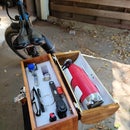Introduction: Driftwood Knife Rack
I have dreamed of building a classic knife rack, ever since our cheap rack fell on the floor and broke. I lucked into some driftwood a tugboat operator friend of mine plucked from the ocean off of Point Bonita. After a little research I discovered the wood is from a mouse hole tree (Myoporum laetum) a native of New Zealand, also an invasive species here in California. It is naturally covered with many small burls that are reminiscent of small coral heads. In New Zealand it's used occasionally for gun stocks. Originally I planned to have the driftwood on the top and bottom of the piece, but, it didn't look right so I added another piece of driftwood to cover the middle piece of walnut.
Step 1: Tools and Materials Required
Table saw
CNC router (you could also build a jig and send the driftwood through a surface planer)
Soda blaster (a few hours of hand scraping will get a similar result)
Bar clamps and C clamps
Radial arm saw (or a wide cut chop saw)
Glue, I used plain old yellow glue
Driftwood, I used 3 pieces approximately 5" in diameter x 20" long
Center block 3"x4" x 20" dry lumber, I used walnut.
Back piece 1"x12" x 20" dry lumber, I used mahogany
Foot 2"x3" x 20" dry lumber, I used mahogany
Step 2: Prep the Driftwood
I was able to get a fairly flat cut with my table saw, without any special jig. After flattening one side I used my homebuilt blasting cabinet to soda blast (basically sandblast with baking soda) the driftwood. I spent some time fannying around with little carving tools to get the last little bits of bark off of the burls, that form all over this wood.
Pro Tip: If you need to de-bark your wood without loosing the natural edge, A high pressure (3500 PSI +) power washer with a narrow tip is the tool to use.
Step 3: 1st Glue Up
Glue the driftwood pieces to the middle 3"x4" piece, I used a chip brush to spread the glue. Clamp with bar clamps and let it set overnight. This wood is ultra hard so I could clamp directly to it without marring. For softer wood use small pieces of sacrificial wood between the clamp and the piece, or plastic tipped clamps.
Step 4: Flatten the Back Side of the Knife Rack
Once the glue was set I mounted the piece in my CNC router and flattened the back side. This was the outer limit for my machine height wise; I had to let one end hang over the edge of the table. Note that I couldn't even fit my dust collecting shoe on the spindle; sawdust flew all over the shop. I cut the ends off on my radial arm saw after machining. Make sure your clamping system is not in the path of the router bit. I used angle braces and wood shims to level and hold the piece.
Step 5: Cut the Knife Slots
After squaring up the ends. I ran the piece through the table saw with the blade set at a 2" height, every 1-1/4" giving a total of 15 knife slots, the width of the slot (kerf) is about 1/8".
Step 6: 2nd Glue Up
Glue the back on. Wait overnight for that to set and glue the foot on. The foot will add stability, to get the correct angle for mine I just stood the knife rack up against the blade of the table saw and adjusted the angle of blade until it aligned with the knife rack. After gluing the back and the foot, I glued another piece of driftwood on the middle section; because it looked wrong without it. Don't be afraid to change a design anytime during the build.
Step 7: Clear Finish
I mixed up some clear unwaxed shellac. Gave the piece 3 coats. Driftwood can be a great addition or base material for many projects.

Participated in the
Shelving Contest













